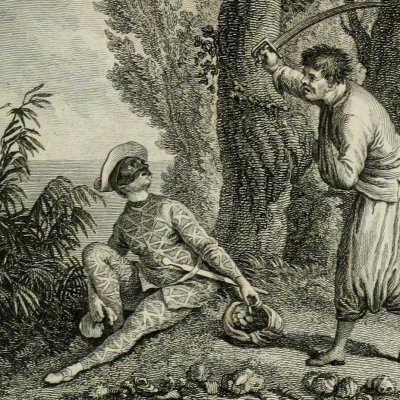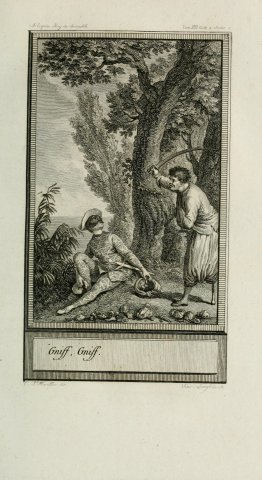A bandit robs Harlequin (Lesage, Selected Works, 1810, vol. 13, Harlequin King of Serendib) - Marillier
Notice précédente Notice n°25 sur 30 Notice suivante
Description
Arlequin has been shipwrecked on the shores of Serendib. Everyone is dead except him. At first, he's delighted to have saved the money of a Maine prosecutor. But a bandit appears and threatens him with his sword. To the tune of "Quand le péril est agréable", a sign then asked the audience to sing:
Ouf! je crains fort pour ma finance!!
Ce drôle a tout l'air d'un voleur.
Le gésier me bondit de peur
A chaque révérence.L'homme pose son turban à terre, fait signe à Arlequin de jeter de l'argent dedans, et le couche en joue en criant: gnaff, gnaff. Harlequin is startled and throws several coins into the turban. The thief withdraws, and another appears with his left arm in a sling, a wooden leg and a large cutlass at his side. This one also curtsies to Harlequin, who always says aside:
Air. When I get some of that October juice. n°3.
What other man offers himself to my view?
He's one-armed! Yes precisely,
He's a rascal; he greets me:
This is gnaff, gnaff, surely.The second thief also puts down his turban, and drawing his cutlass beckons Harlequin to throw money into it, saying: gniff, gniff. (Act I, scene 1)
The robbers throw Harlequin into a barrel and flee. A wolf sniffing out fresh meat tries to eat him. Harlequin rips off its tail. The barrel opens in two and the wolf flees: end of scene 1.
- Signed below the engraving on the left "C. P. Marillier dir.", right "Vinc: Langlois Sc."
Caption: "Gniff, Gniff." - Farce in three acts performed in signs by the troupe of Baxter and Saurin, placed under the direction of the widow Baron, at the theater of the Foire Saint-Germain on February 3, 1713 and published in 1721 by Étienne Ganeau.
From January 2, 1709, actors at the Foire were forbidden to speak. Signs with verses were hung above the stage, allowing the audience to sing the lines, to tunes known at the time, played by musicians. This practice gave rise to comic opera. Lesage wrote seven pieces à écriteaux.
This engraving is inserted second in the volume, although it represents the 1st scene, probably because, produced by Marillier, it comes after the previous one, produced for the 1724 volume.
Technical Data
Notice #024890


